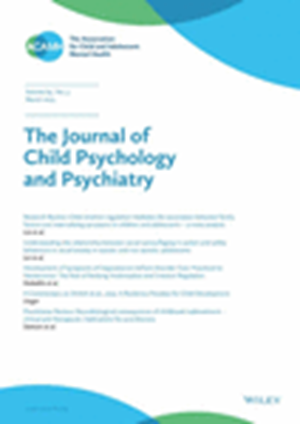Mid-childhood developmental and behavioural outcomes in infants with a family history of autism and/or attention deficit hyperactivity disorder.
IF 7
1区 医学
Q1 PSYCHIATRY
引用次数: 0
Abstract
BACKGROUND Prospective studies of autism family history infants primarily report recurrence and predictors of autism at 3 years. Less is known about ADHD family history infants and later childhood outcomes. We characterise profiles of mid-childhood developmental and behavioural outcomes in infants with a family history of autism and/or ADHD to identify potential support needs and patterns of co-occurrence across domains. METHODS Two hundred and sixty-three infants (51% male; N = 198 autism/ADHD family history; N = 65 no family history) were assessed at 6-12 years. A latent profile analysis (LPA) with indicator variables measuring developmental abilities (IQ, adaptive function) and behavioural traits (autism, ADHD, anxiety) identified dimensional, data-derived outcome classes. RESULTS A seven-class solution was the most robust and clinically meaningful. Two classes (27% and 23%) had typical development; two classes had high autism, ADHD, and anxiety traits-one with low IQ and adaptive function (10%) and one with average IQ but low adaptive function (13%); one class had elevated autism and ADHD but not anxiety traits (10%); and the final two classes had elevated ADHD (9%) and anxiety (8%) traits in isolation. Sex distribution was balanced across all classes. Children with autism were found in all classes but predominantly in the classes with low IQ/adaptive functioning and high behavioural traits, as well as in the class with elevated autism and ADHD traits. We found only partial continuity between membership of similarly derived 3-year LPA classes and mid-childhood LPA classes. CONCLUSIONS Many autism/ADHD family history infants develop typically. However, by mid-childhood, in addition to those with autism, others show elevated neurodevelopmental (autism, ADHD) and neuropsychiatric (anxiety) behavioural traits. Lower developmental abilities (IQ and adaptive function) are primarily seen in children with an autism diagnosis. Family history infants should be monitored through childhood, and support provided should challenges emerge.有自闭症和/或注意缺陷多动障碍家族史的婴儿的童年中期发育和行为结果
背景:对自闭症家族史婴儿的前瞻性研究主要报告了3岁时自闭症的复发和预测因素。对于多动症的家族史,婴儿和儿童后期的结果,我们所知较少。我们对有自闭症和/或ADHD家族史的婴儿的童年中期发育和行为结果进行特征描述,以确定潜在的支持需求和跨领域共发生的模式。方法对6-12岁的263名婴儿进行评估,其中男性占51%,有自闭症/ADHD家族史的198例,无家族史的65例。潜在轮廓分析(LPA)与指标变量测量发展能力(智商,适应功能)和行为特征(自闭症,多动症,焦虑)确定维度,数据派生的结果类别。结果tsa 7级溶液稳健性最强,具有临床意义。两类(27%和23%)发展典型;两类具有高自闭症、多动症和焦虑特征——一类具有低智商和低适应功能(10%),另一类具有平均智商但低适应功能(13%);一个班级的自闭症和注意力缺陷多动症升高,但没有焦虑特征(10%);最后两类单独出现ADHD(9%)和焦虑(8%)特征升高。性别分布在所有阶层中都是平衡的。所有班级都有自闭症儿童,但主要出现在智商/适应功能低、行为特征高的班级,以及自闭症和多动症特征较高的班级。我们发现类似衍生的3年LPA班级和儿童中期LPA班级的成员之间只有部分连续性。结论许多有自闭症/ADHD家族史的婴儿发育典型。然而,到了儿童中期,除了那些患有自闭症的人,其他人表现出神经发育(自闭症、多动症)和神经精神(焦虑)行为特征的升高。较低的发展能力(智商和适应功能)主要见于被诊断为自闭症的儿童。有家族史的婴儿应该在童年时期进行监测,并在出现挑战时提供支持。
本文章由计算机程序翻译,如有差异,请以英文原文为准。
求助全文
约1分钟内获得全文
求助全文
来源期刊
CiteScore
13.80
自引率
5.30%
发文量
169
审稿时长
1 months
期刊介绍:
The Journal of Child Psychology and Psychiatry (JCPP) is a highly regarded international publication that focuses on the fields of child and adolescent psychology and psychiatry. It is recognized for publishing top-tier, clinically relevant research across various disciplines related to these areas. JCPP has a broad global readership and covers a diverse range of topics, including:
Epidemiology: Studies on the prevalence and distribution of mental health issues in children and adolescents.
Diagnosis: Research on the identification and classification of childhood disorders.
Treatments: Psychotherapeutic and psychopharmacological interventions for child and adolescent mental health.
Behavior and Cognition: Studies on the behavioral and cognitive aspects of childhood disorders.
Neuroscience and Neurobiology: Research on the neural and biological underpinnings of child mental health.
Genetics: Genetic factors contributing to the development of childhood disorders.
JCPP serves as a platform for integrating empirical research, clinical studies, and high-quality reviews from diverse perspectives, theoretical viewpoints, and disciplines. This interdisciplinary approach is a key feature of the journal, as it fosters a comprehensive understanding of child and adolescent mental health.
The Journal of Child Psychology and Psychiatry is published 12 times a year and is affiliated with the Association for Child and Adolescent Mental Health (ACAMH), which supports the journal's mission to advance knowledge and practice in the field of child and adolescent mental health.

 求助内容:
求助内容: 应助结果提醒方式:
应助结果提醒方式:


